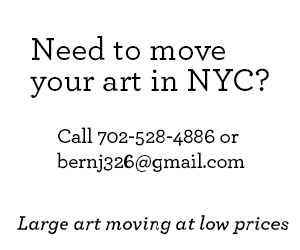Contemporary Art Trends and What This Means for Us
15 Mar2011
The Armory Show in New York is one of the largest and most prestigious annual exhibitions for contemporary and modern art. Recently, the airy warehouses on piers 44 and 42 on NY’s Hudson River housed galleries from all over the world for this high end display of industry excellence. The industrial space buzzed with excitement presenting the most cutting edge work on the contemporary art scene.
We took a look at the trends that defined this year’s Armory Show to give you the industry ins and outs with insights from our Jewish perspective.
The most defining characteristic presented this year was the altered perception of space. Artists manipulated depth with distorted imagery and use of 3D materials, blurring the realms of illusion and reality. The result makes the viewer question what they are really looking at and makes the subject matter more intimate.
One such example (see figure A) uses a multi-layer illusionary display. Initially it looks like a photograph but after a couple seconds the middle section starts moving and the viewer realizes there is a screen behind the image. The images on the screen are so well match to the depth and perspective of the photograph that it works seamlessly. The screen pushes the depth, as well as adds movement to the photograph. After another look one notices the hand painted connecting the screen to the photograph, pushing the illusion and bring an element of scale. Together this work mixes 3 different mediums and challenges what is real and what is illusionary.
In Judaism we understand that what we see with our eyes isn’t necessarily what is “real.†By acknowledging that there is something else being communicated than what is on the surface we are able to enrich our sense of purpose and duty. Questioning the superficial as real is a constant reminder to look beyond the surface in search of truth.
Texture and non-traditional materials were prominent this year, taking the art and moving it up off the surface in depth and often right off the surface plane. In many cases pieces of everyday life become beautiful and elegant. Â In this work (see figure B) ordinary sneakers of different colors are used to build surface and texture allowing the viewer to see past the fact that it is made of sneakers at all.
The use of ordinary materials to create extra-ordinary imagery is very close to how ritual is practiced in Judaism. Ritual can use the simplest of materials, a cup for washing, a candle for light, or a piece of bread. It is when these objects are used in such a way that evokes something beyond what the object is itself that the ritual and evocation holds meaning.
This year we also saw a lot of use of vivid color, reminiscent of pop art. The theory behind vivid color is a balance between strong visual frequencies. The elements that make up a color as well as the weight of color when placed near another, has a strong effect on the way we see an image. One color actually changes our perception when compared to another. The boldness of the colors used here show an upfront daring quality which says our culture is not timid, is not modest. It is almost like a visual call to action, to be present, be awake, as if there is something to pay attention to.
In Jewish practice there is also a frequency to our call to action. We are commanded at certain times to be aware to specific elements, and other times not. This fluctuation is consistent with the changing of the seasons which also have the qualities that colors are attributed to, light and dark, cold and warm. The practices during the different times of the year balance us to the changing times. In the heat of the summer when our energy level is high, the longest and most defeating fast day is upon us, Tisha B’Av, which brings our energy levels back down. Similarly, in the cold depths of winter the holiday of Chanukah illuminates our spirits and gives us the warms that is lacking at that time of the year.
So what did we learn from the Armory Show? We saw a strong influence by individualized media personalizing the viewer’s experience. The quest for illusion relates to our quest for reality, and through materials and vibrant frequencies we awaken the mind to places where this may be found. Even if it is hidden beneath a pile of sneakers.
- In: Exhibition Reviews
- Tags: NYC, Painting, Sculpture








